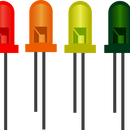Introduction: Lino and Stamps Printing Press
Some years ago, in Art Course, which I followed at evening, we had a few evenings about printing. We had to cut our own lino (not our fingers) from a drawing we made by ourselves, after it was ready we could print it.
I loved that work. After a while, I started looking for art suppliers, found out that those presses were way beyond my financial means. At least, if I would avoid war at the home front...
I tried to make one, very simple: two wooden plates that were pushed together with a lever. It "worked", but not good enough for me. And it took lots of place in my workshop.
Thinking hard... The very first presses were made out of wood, they had a wooden screw that transformed the rotating force in pressure. Where would I find that? Sitting on a barstool, I made my brains work overtime. It was an adjustable, old, wooden barstool. You had to spin the seat to adjust the height. Hang on, wait a second?
I hardly knew people in the wood-working-industry. Who could make a wooden screw for me.
I reached for a notepad next to me, and almost fell of that darn barstool. Then I thought I found it!
Step 1: Dismembering Furniture
As you can see, that barstool gives more than enough parts I could use. My very first idea was to use the seat as the top plate, the one that pressed on the lino. But I was afraid that, because it was fixed on the screw, it would turn when applying pressure and so it could ruin the print itself.
So I had to make a rectangular plate, but be sure the screw should not have too much of resistance, to avoid turning of the plate.
The wood I use is from pieces that were "lying around". I didn't much care for dimensions in the beginning, I had to measure what I have.
So for the bottom plate, that supports the paper, I took a 16mm plate, cut it in 43cm by 38cm (17" x 15", 0.6" thick).
The top plate, that takes all the force was a little smaller, just to make it easier to remove: 42cm x 28cm x18mm. (16.5" x 11" x 0.7") And, it consists of 3 stacked glued pieces. The inner diameter of the top part is about 1.5", 38mm.
Those were the first parts.
Step 2: Putting It All Together.
The wooden nuts are placed on planks. Using both of the "salvaged" nuts gives the wooden screw more stability. It gives it a straight, non-wobbling pass.
Since I had that wood lying around, no real considerations about the dimensions. They come from a longer, 16mm x 95mm plank (6.3" by 3 3/4 ") I think it will be more than strong enough.
To be sure that both nuts were aligned perfectly, I screwed them on the screw, firmly held them together with clamps.
I drilled two holes of 8mm through en trough. These were my markers.
Placed the first nut on both planks, drilled the holes for the pens, glued them. I used the markers for aligning the second nut, repeated last step.
Clamped them together, let it rest overnight.
Step 3: Wobbling, But Got It Straight.
How to get a wobbling structure stable?
That was really something to think about. As the hole in the upper part of the top plate had the same diameter as the screw, it held the screw and nuts structure quite steady.
For attaching the sides of the press, making it a strong structure, I had to make sure everything lined up straight.
With the help of three spirit levels, I got it straight. But since it had to stay that way, I clamped it with some longer wood, taking care of the levels.
So I could measure the sides, prepare those, drill the holes, put the pens in. When one side was done, I mounted those (without glueing them), stabilised it with clamps, and measured, drilled and prepared the other side.
The side beams are in wood, 45mm x20mm x 400mm high (1 3/4" x 3/4" , height 15 3/4"). Again, strong enough.
With help of some 2" x 2"'s (5cm x5xm) I succeeded to clamp them in my workbench. Leaving the glue to cure for about two hours, I removed it, turned around, and glued the other ends.
And left it there, minding its own business.
Step 4: Take It to the Test.
So this is how it looks like, right now.
It is sturdy, I only had to make one more step: the seat of the stool wasn't too well attached to the screw. So in my first test, it kept on turning while the screw itself was blocked. After some scary moments, I got it released. I dismantled it, gave it a big blob of glue. Drilled a hole in it and locked it tight with a long wood-screw.
Try two, with the lino cut. For a better print, it is best you place a piece of felt under the lino. This picture is actually a bad setup, as I see it now... You should actually place the paper on the felt, the lino on top...
But I think this gives an idea how it works.
Step 5: Printtest :-)
From an old barstool to a print...
I'm quite proud of it :-)
When I have some time left, the only thing to do is to sand it down and paint it.
I think I'll stain the wood... With some dark oak colour.
Thanks for reading, maybe I can inspire someone?











